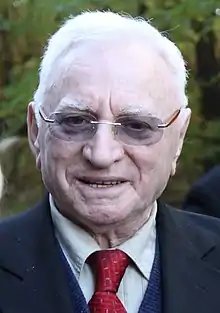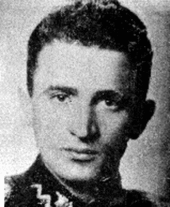Thomas Blatt
Thomas "Toivi" Blatt (born Tomasz Blatt; April 15, 1927 – October 31, 2015) was a Holocaust survivor,[2] writer of mémoires, and public speaker, who at the age of 16 escaped from the Sobibór extermination camp during the uprising staged by the Jewish prisoners in October 1943. The escape was attempted by about 300 inmates,[3] many of whom were recaptured and killed by the German search squads. Following World War II Blatt lived in Communist Poland until the Polish October. In 1957, he emigrated to Israel, and in 1958 settled in the United States.[3]
Thomas Blatt | |
|---|---|
 Blatt in 2013 | |
| Born | Tomasz Blatt April 15, 1927 |
| Died | October 31, 2015 (aged 88) |
| Nationality | Polish American |
| Other names | Toivi Hersz Ber Blatt, Bolesław Stankiewicz, Tobiasz Blatt |
| Known for | Survivor of the Sobibór extermination camp uprising |
| Spouse(s) | Teodozja Kowalik, Dena Blatt[1] |
| Children | Rena Blatt/Smith Leonard Blatt[1] |
Life
Thomas "Toivi" Blatt was born on April 15, 1927, to a Jewish family in Izbica, Second Polish Republic, where his father Leon Blatt owned a liquor store. The population of the town was 90 percent Jewish at the time according to the Holocaust Encyclopedia.[3] Tomasz (Toivi) also had a brother. During the occupation of Poland by Nazi Germany in World War II, his family was forced into the Izbica Ghetto created by the SS in 1941, the largest transit ghetto in the Lublin Reservation.[4] In October 1942, the family decided to split up and leave Izbica to increase their chance of survival. Tomasz Blatt tried to reach Hungary. On the way he was captured and imprisoned, first in a prison in Stryj and then in the Ghetto Stryj. In early 1943,with the help of an acquaintance of his family, Blatt went back to Izbica to his parents and his brother.[5] On April 28, 1943, Blatt was taken to Sobibór by truck with about 400 Jews from Izbica.[6] Members of his family were killed there on arrival. Thomas (age 16) along with 40 young men was selected to join the Arbeitsjuden in the Lower, and later, the Upper Camp, where he cut the hair of naked women before gassing.[6]
During the one year and a half in which the Sobibór killing centre operated, at least 167,000 people were murdered there, according to the United States Holocaust Memorial Museum;[7] virtually all of the victims were Jews, mostly from Poland, France and the Netherlands. Other estimates range from 200,000 (Raul Hilberg) to 250,000 (Dr. Aharon Weiss, and Czesław Madajczyk).[8]
Escape from Sobibór
Blatt was among some 300 prisoners who escaped from the camp during the uprising staged by the Sobibór underground on October 14, 1943.[9]
Emigration

In 1957, Blatt emigrated from Stalinist Poland to Israel and in 1958 settled in the United States.[3] In the late 1970s and 1980s, he worked for Richard Rashke, an American journalist and author who wrote the Escape from Sobibor first published in 1982. Blatt was commissioned by Rashke to help him locate and interview Sobibór survivors for the story of the revolt.[13]
Blatt also did his own research. In 1983, he interviewed Karl Frenzel after his release from prison,[14] a Nazi German who had been third in command at Sobibór. Frenzel, convicted at trial and sentenced to life in prison for his actions at the camp, was released on appeal after serving 16 years. Blatt later claimed that his interview was the first one after World War II in which an extermination camp survivor spoke face-to-face with a camp functionary.[3][15]
The 1983 book by Rashke was adapted into the award-winning 1987 television film, Escape from Sobibor. It portrayed the events leading up to, and including the uprising in Sobibór. Blatt served as a technical adviser on the film. The revolt leaders Leon Feldhendler and Alexander Pechersky, as well as other camp prisoners including Blatt were played by actors. The film was directed by Jack Gold and shot in Yugoslavia.[13]
Blatt wrote two books about Sobibór. His first mémoire, From The Ashes of Sobibor (1997),[16] is about his life before the war and the German occupation of Izbica leading up to the deportation of his family to the Sobibór death camp. His second mémoire titled Sobibor: the forgotten revolt (1998)[1] also based on his own experience and supplementary research, and written with the help of his son Leon Blatt,[1] describes the story of the prisoner revolt of October 14, 1943, as remembered by Alexander Pechersky and others.[17] The book material was used as the source for his personal website by the same name.[18]
Blatt lived in Santa Barbara, California. He died at his home on October 31, 2015, at the age of 88.[19][2]
References
- Blatt, Thomas Toivi (1998). Sobibor, the Forgotten Revolt: A Survivor's Report. H.E.P. ISBN 0-9649442-0-0. Acknowledgements.
- Roberts, Sam (November 2, 2015). "Thomas Blatt, Who Escaped Death Camp During Revolt, Dies at 88". The New York Times. Retrieved November 3, 2015.
- Kowalczyk-Nowak, Agnieszka (November 2, 2015). "Tomasz Blatt (1927–2015)". Majdanek State Museum.
- Virtual Shtetl. "Izbica. The Jewish History". Museum of the History of Polish Jews. page 3 of 6. Archived from the original on September 24, 2015 – via Internet Archive.
- Blatt, Thomas Toivi (1997). From the ashes of Sobibor : a story of survival. Christopher R. Browning. Evanston, Illinois. ISBN 0-8101-1302-3. OCLC 36597665.
{{cite book}}: CS1 maint: location missing publisher (link) - de Ree, Erik (2012). "Thomas Blatt". Sobiborinterviews.nl. The Netherlands Institute for War Documentation (NIOD). Archived from the original on March 9, 2016 – via Internet Archive.
{{cite web}}: CS1 maint: bot: original URL status unknown (link) - USHMM (2012). "Sobibor: Chronology". United States Holocaust Memorial Museum, Washington, DC. Archived from the original on August 15, 2012 – via Internet Archive.
{{cite web}}: CS1 maint: bot: original URL status unknown (link) - Eberhardt, Piotr; Owsinski, Jan (2015). Estimated Numbers of Victims of the Nazi Extermination Camps. p. 124. ISBN 978-1-317-47096-0. Retrieved September 19, 2015.
{{cite book}}:|work=ignored (help) - "Thomas Blatt – Sobibor Interviews". March 9, 2016. Archived from the original on March 9, 2016. Retrieved February 22, 2018.
{{cite web}}: CS1 maint: bot: original URL status unknown (link) - "Institute of National remembrance Archives, Personal dossier report".
- "Nederlands Instituut voor Oorlogsdocumentatie (NIOD).Sobibor interviews, Survivors of the revolt(1984)".
- "Institute of National Remembrance Archives, Personal dossier report".
- "Escape from Sobibor by Richard Rashke". University of Illinois Press. University of Illinois. Archived from the original on July 1, 2012 – via Internet Archive: July 1, 2012.
{{cite web}}: CS1 maint: bot: original URL status unknown (link) - Smart, Victor; Webb, Chris (2012). "Sobibor survivor Thomas Tovi Blatt confronts Death Camp Commandant Karl Frenzel in 1983". HolocaustResearchProject.org. Holocaust Education & Archive Research Team.
- The Holocaust Encyclopedia (2018). "Tomasz (Toivi) Blatt. Born: April 15, 1927. Izbica, Poland". United States Holocaust Memorial Museum, Washington, DC.
- WorldCat; Blatt, Thomas Toivi (1997). From the Ashes of Sobibor: A Story of Survival. Evanston, NU Press (reprint). ISBN 0-8101-1302-3. OCLC 645873594.
- Blatt, Thomas Toivi (2000), Sobibor – The Forgotten Revolt, H.E.P., pp. 3, 92, ISBN 0-9649442-0-0 – via Google Books, snippet view
- "Sobibor, The Forgotten Revolt". Sobibor.net.
- Gera, Vanessa (November 2, 2015). "Thomas Blatt, survivor of escape from Sobibor dies at 88". USNews.com. Associated Press.
External links
- Sobibor – The Forgotten Revolt, by Thomas Toivi Blatt
- Thomas Blatt – videotaped testimony – interviewed April 4, 1995, USC Shoah Foundation Visual History Archive Online
- Interview with Sobibor Survivor Thomas Blatt: 'Demjanjuk Should Confess' – May 13, 2009, Der Spiegel
- Interview of Thomas Blatt – October 14, 2011, WMRA
- Thomas Blatt dies at 88; among 300 Jews who escaped Nazi death camp at Sobibor – November 3, 2015, Los Angeles Times
- ‘I’m still there – in my dreams,’ said Thomas Blatt, survivor of daring escape from Nazi death camp – November 3, 2015, The Washington Post
- Photos of Nazis at Sobibor death camp are the first of their kind – January 27, 2020, The Washington Post
- Escape from Sobibor at IMDb